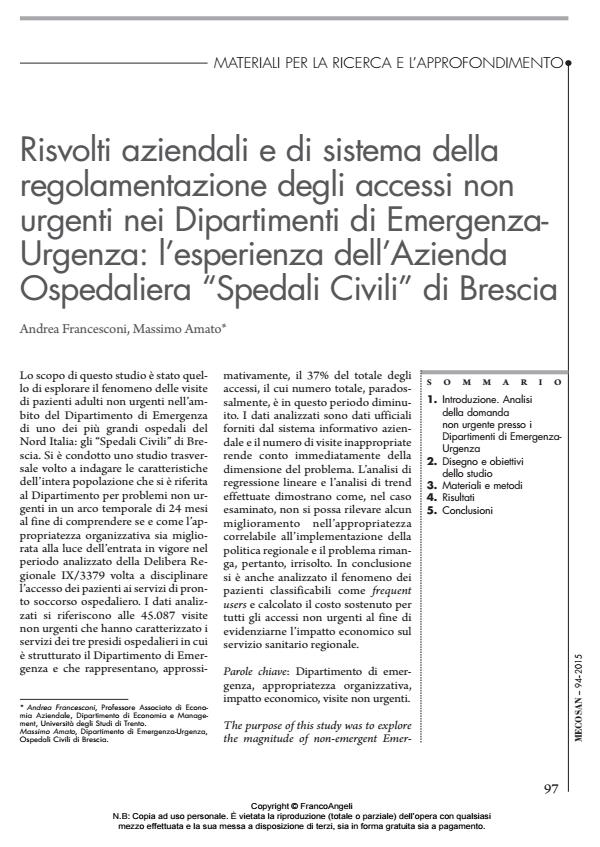Risvolti aziendali e di sistema della regolamentazione degli accessi non urgenti nei Dipartimenti di Emergenza-Urgenza: l’esperienza dell’Azienda Ospedaliera "Spedali Civili" di Brescia
Journal title MECOSAN
Author/s Andrea Francesconi, Massimo Amato
Publishing Year 2015 Issue 2015/94
Language Italian Pages 17 P. 97-113 File size 20890 KB
DOI 10.3280/MESA2015-094006
DOI is like a bar code for intellectual property: to have more infomation
click here
Below, you can see the article first page
If you want to buy this article in PDF format, you can do it, following the instructions to buy download credits

FrancoAngeli is member of Publishers International Linking Association, Inc (PILA), a not-for-profit association which run the CrossRef service enabling links to and from online scholarly content.
The purpose of this study was to explore the magnitude of non-emergent Emergency Department (ED) visits by adults in one of the biggest hospital in north Italy, the "Spedali Civili" of Brescia Hospital. We performed a cross-sectional study aimed to investigate the whole population referring to ED with nonurgent conditions in 24-months time and to understand whether the organizational appropriateness has improved since Lombardy Region regulation IX/3379 entered into force. The data contained 45,087 non-emergent visits of the ED of three hospitals, nearly 37% of all accesses that are paradoxically decreasing in these years. All patients’ data have been provided by local ICT and the full number of improper visits supplies the exact dimension of the problem. Trend-lines and linear regression analysis have shown there is no improvement in appropriateness by this attempt of Lombardy Region on counteraction to this unresolved problem. At the end, we analyzed the phenomenon of the ED frequent users and calculated the costs of all non-urgent accesses to highlight the economic impact of this cohort of patients for the Regional Health Service.
Keywords: Emergency Department utilization, Organizational Appropriateness, economic impact, non-urgent visits
Andrea Francesconi, Massimo Amato, Risvolti aziendali e di sistema della regolamentazione degli accessi non urgenti nei Dipartimenti di Emergenza-Urgenza: l’esperienza dell’Azienda Ospedaliera "Spedali Civili" di Brescia in "MECOSAN" 94/2015, pp 97-113, DOI: 10.3280/MESA2015-094006